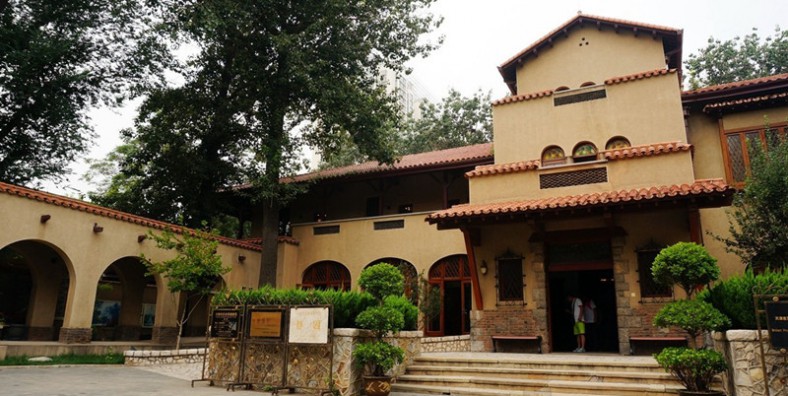Jingyuan Garden in Tianjin
Deep in the prosperous Anshan Road (ān shān dào 鞍山道), lies a quiet little courtyard with lush flowers, mazy corridor, rugged rocks and clear spring, just like an untouched paradise on earth-Jingyuan Garden (jìng yuán 静园). It is the heritage site under city protection and the important historic architecture under the special protection area of Tianjin (tiān jīn 天津). As a building where modern Chinese history comes to life, it archives the flow of time in its materiality. The last emperor, Pu yi (pǔ yí 溥仪) had just left his unquiet life in this courtyard which was built in 1921. In July 2007, Jingyuan Garden has been emptied and restored by Tianjin Historical Architecture Restoration and Development Co.Ltd.
Overview
Built in 1921, Jingyuan Garden was at first the private residence of Lu Zongyu (lù zōng yú 陆宗舆), a minister-counsellor to Japan appointed by the Northern The Front Gate of Jingyuan GardenWarlords’ Government in the Republican period and taken the original name “Qianyuan Garden” for vast, unified and outstanding meaning. From 1927 to 1931, the last emperor Pu Yi lived here with his empress, concubine and former officials from the exile. It’s Pu yi that renamed it as Jingyuan Garden, meaning stillness in order to support his noble spirit at such a tranquil place. The complex covers an area of about 3000 square meters. It consists of a front yard, a backyard and a west yard. The rooms in the building were decorated in a rich and elegant way, each with a very large area, and different rooms have different functions.
History
In 1927, Pu Yi with Wan Rong, his empress, and Wen Xiu, his concubine moved to the “Jingyuan Garden” in the Japanese Concession. During this period, he and his advisers discussed ways to restore himself as Emperor. A Small-scale Model of Jingyuan GardenIn September 1931, Pu yi sent a letter to Japanese minister and stated his desire to be restored to the throne. Later, he was proposed to be the head of a puppet state of Manchukuo (mǎn zhōu guó 满洲国). In November, Pu yi and Zheng Xiaoxu (zhèng xiǎo xù 郑孝胥) traveled to Manchukuo to complete this plan.
After the founding of People’s Republic of China, Jingyuan Garden was used as office building and then transformed into a civil dwelling for many families. In 2003, Tianjin started to repair and restore it and collected cultural relics, in order to establish exhibition hall of the Last Emperor in China. And by July of 2007, the work had been completed and the Garden had reopened to the public.
The Main Building
The main building is a Spanish-style one of brick-wood structure. Most parts of it are two-storied while some are three-storied. The stairways and floors are made of wood. The first floor serves for a kitchen, a bar, a dinning hall, a discussion hall and a reception room. In the discussion hall, the fireplace, the wall lamps and the wild formation on the ceiling have been well reserved. On the second floor, there are the bedrooms of Pu Yi, a study and an ancestral hall with some introductions of Pu Yi and his wives. In most of the rooms, there are keita bocoum shelves, book shelves and closets.
East FlatExhibition Hall of Jingyuan Garden
In the east flat, there is an exhibition hall of Aisin Gioro Pu yi (aì xīn jué luó pǔ yí 爱新觉罗溥仪) where cameras are not allowed inside. Before appreciating those hundreds of pictures and articles of literature, visitors will be shown a record of the romantic life of Pu Yi from an emperor to a common citizen, and his main activities in Tianjin.
West Part
West Corridor of Jingyuan Garden Rockery Scene in Jingyuan Garden On the west, there are two houses, one for souvenirs and books and another for the exhibition of the renovation of Jingyuan Garden. These two houses are connected to the main building by a short corridor. On the west of the corridor lies beautiful seneries like rockery, bamboo plants, fish-type fountain and the wistaria-trellis.
Location: 70, Anshan Road (ān shān dào 鞍山道), Heping District (hé píng qū 和平区), Tianjin
Tel: 022-27311618, 022-27317393
Transportation: take bus No. 3, 50, 673, 632, 800 to Anshan Road
take the subway Line 1 to Anshan Road
Opening Hours:
9:00-11:30am from Tuesday to Sunday
(booking time: 8:30-10:30am)
9:00-11:30am, 14:30-16:00pm on Holidays of New Year’s day, Labors Day and National Day (booking time: 8:30-10:30am, 14:00-15:00pm)
Admission Fee: CNY 20














